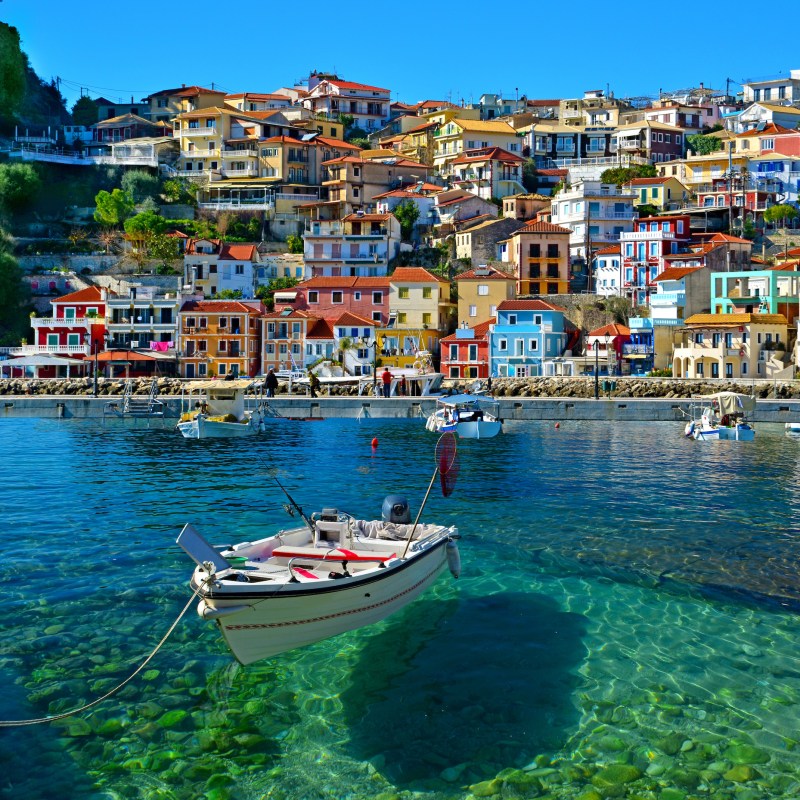
Everybody’s heard of Santorini and Mykonos — they’re the most famous Greek islands.
Videos by TravelAwaits
And you might’ve heard of some that made our list of the seven Greek islands you must visit, which introduces some more popular ones. However, not even many Greeks have heard of the Diapontia Islands, a cluster of islands, islets, and even rocks located some six miles northwest of the Greek island of Corfu in the blue waters of the Ionian Sea.
“Where are you going?” my Greek friends would ask me. I was surprised that they’d not heard of this chain until I took the journey to discover them for myself. They’re not that complicated to reach; just a flight to Corfu or, if you’re feeling adventurous and coming from Italy, many people yacht over. From Corfu, there is Joy Cruises, which will take you from the main harbor (a mere five-minute taxi drive from the airport), then, in just over an hour, you’ve reached Ereikousa, the nearest of the islands. Or take a taxi for about an hour to the northernmost tip of Corfu to the small Port of Sidari and hire a small motorboat and skipper for a 40-minute private transfer. Corfu Holidays Direct is the perfect outfitter to use; they have a multilingual staff and spacious air-conditioned vans.
The islands themselves were inhabited after the mainland Battle of Nafpaktos in 1571. Islanders from the occupied island of Paxos and Parga on the mainland fled their homes to seek refuge elsewhere, and these small outcrops, the Diapontians, saw the population grow.
At only 1.9 square miles, Ereikousa is one of the largest in the chain. So let’s take a look at what you can do on this small archipelago and how to spend your time. As they are so small and relatively unknown, even to the Grecian market, I recommend them for a visit to a virtually uninhabited region of Greece — the real side of the country.

Corfu
Let’s start by looking at the most popular island in the Ionian Sea and the nearest to the Diapontian archipelago: Corfu. At 226 square miles, the island certainly has a lot to offer all visitors. The airport is approximately two miles south of Corfu Town. There’s a main port, where cruises depart from and where domestic and international ferries, for example, those heading to and from Albania and Igoumenitsa, the gateway port city in northwest Greece where many ferries connect to Italy, dock. It’s possible to connect to the Diapontia Islands from here, too.
Corfu has 134 miles of coastline, meaning there are many beautiful beaches and coves all around the island, yet for me, the pull is the Venetian Old Town in Corfu Town and the culture of the island. The Venetian Historic Fort of the Old Town sits proudly atop the hill, guarding her city — it’s possible to visit inside every day.
Wander the cobbled streets of the Old Town, take the weight off your feet by sitting outside a coffee shop, and watch real Greek life around you: washing strung across the streets, old ladies chatting. Mountainous interior, monasteries, lush vegetation, and the blue, blue sea — Corfu really does have it all, plus it’s easy to reach via many connecting European flights or from Athens.

Ereikousa
From the Port of Sidari in north Corfu, Ereikousa is just eight nautical miles away and is the northernmost inhabited island in the Ionian Sea, one of the largest in the Diapontian chain. With a tiny population of just 30 — the school has two pupils, and there’s no bank or ATM machine so be sure to take euros out in Corfu — this really is a place to come and get away from it all.
Let go of all of your expectations and really connect to the real Greece on this island, whose name comes from the Greek reiki, which means “briar plants” in English and is a nod to the purple gorse bush that flourishes across the island in October. Spend more than one night in one of the two hotels: Erikousa Hotel and Acantha Boutique Hotel, both located in the port, and soon you’ll be part of the small community, greeted by fishermen and drinking raki with the locals at the small taverna.
Walk the small hiking trails through pine forests. Ereikousa is certainly not a mountainous island, the highest spot is under 430 feet, but it’s good to take an early morning or later evening walk as temperatures can get high in the summer. The sound of cicadas fills the air as they try to cool off.
With its golden sands, the coastline beyond the port to the northwest of the island is steep and rugged, so only reachable by boat. Both hotels offer yacht services or can take you out themselves.
Swim, walk, relax, eat good local food. Ereikousa is the real Greece.

Othoni
The biggest island in the Diapontia chain, Othoni is still small in size. At four square miles and a mere 40 nautical miles from the Italian Cape of Otranto, it has managed to maintain its charm and is, thankfully, untouched by mass tourism.
There are only small rooms to rent on Othoni, making it another authentic Greek experience, hence visitors either base themselves on Ereikousa and take trips with yachts or sailing ships, or come via Italy or Corfu.
The island has a well-documented maritime history that spans from the start of the 19th century. Up until WWII, a great number of the local population owned their own ships and traded far and wide in the Aegean, the Adriatic, and the Black Sea, plus the Eastern and Western Mediterranean as a whole.
The two main settlements are Ammos on the coast with the Chora in the mountains in the center of the island. At the eastern point is Cape Kastri, with its ruinous Venetian Fort, and Faros, the impressive lighthouse, originally built in 1872 at over 300 feet above sea level, which was destroyed by the Germans in WWII but then reconstructed.
The west coast’s Aspri Amos beach is your best bet for relaxing on white sand. Calypso’s Cave is located here, and the rock reflects in the emerald water. Legend has it that Odysseus saw Calypso here and was so captivated by her beauty, he remained a prisoner for seven years.
Unique like Erikoussa, Othoni is a destination for unspoiled and genuine tourism.

Mathraki
Mathraki is only 1.1 square miles in size, making it the smallest in this archipelago, hence things to do on the island are very limited. As you’re probably gathering by now, the Diapontians are so small that you have to be a fan of total relaxation and letting go.
Nevertheless, the port offers a couple of tavernas that are good for eating in once a swim and relax on the beach has been had. Should you wish to stay the night, there are a couple of hotels, too.
Portello is a beach next to the port and takes over much of the northeastern side of the island — it has very clear waters and steepens gradually, whereas the coast on the northwestern part of the island is more rugged and a haven for scuba divers and speargun fishermen. Saint Nikolas is the Saint of Seafarers, and as most islanders in this chain have fishing as their livelihood, there is a church and chapel dedicated to this saint.
Wander through olive groves and pine forests between the port and Chorio — the capital of the island — and you’ll see a handful of houses, people tending their land, and spectacular views of the sea. It’s possible to walk around this island in three to four hours, depending on the season and your speed.
It may be small in size, but Mathraki certainly makes up for this in beauty and tradition.
Now we come to the uninhabited islets, which are still worth mentioning, though there’s less information to share about them due to their size.

Diapolo
The islet of Diapolo can be viewed from the northwestern coast of Corfu and is located east of Mathraki. It’s known as the Island of Donkeys as several used to roam there. There are no facilities, as you can imagine, but it’s good to visit for a day to relax on the beach around the small coast. It’s rumoured there are even wild goats there feasting on the lush vegetation. You’ll also find flint rock here that was used in the past by residents in Corfu during the Mesolithic period to make tools.
Reach Diapolo by hiring a boat from Corfu or any other Diapontian island.

Diakopo
A rocky islet just to the southwest of Diapolo, not much is known about Diakopo. It’s very rocky; hence, it’s only really possible to moor up and swim around the island in the waters and have lunch on the boat. Take a trip from any of the slightly more inhabited Diapontian islands such as Ereikousa or Orthoni, or travel from Corfu.

Trachia
Trachia is a satellite islet of Mathraki, to the northwest, and can be viewed from there. People visit by day trip from other Diapontian islands and, again, moor up to swim in the waters surrounding it. It may be possible, as with Diapolo, to see wild goats feasting on the vegetation.
All in all, the Diapontians are your perfect get-away-from-it-all islands and islets. Things really are on Greek time here. No mass tourism exists, in fact tourism is not the main source of income; fishing is. If you’re staying on one of the bigger islands and are lucky enough to befriend a fisherman, and this is perfectly viable given how friendly everyone is, you may be invited out on a fishing trip at 4 a.m. Be prepared to let go of expectations and enjoy your time in the Diapontians.
